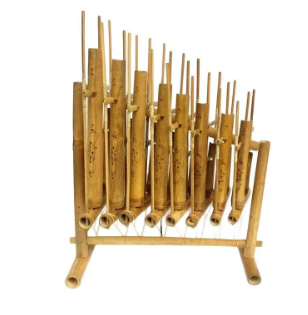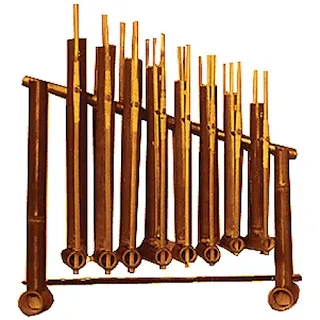Explanation of Angklung traditional musical instruments originating from the Sundanese people of West Java. Angklung is a multitonal (double-pitched) musical instrument made of bamboo. How to play it is quite easy just by shaking it.
The sound produced is caused by the impact of the bamboo pipe body. The resulting sound vibrates in a tone arrangement of 2, 3, to 4 tones in each size, both large and small.
Jonathan Rigg's Dictionary of the Sunda Language, published in 1862 in Batavia, writes that angklung is a musical instrument made of bamboo pipes, cut at the ends, resembling pipes in an organ, and tied together in a frame, vibrated to produce sound.
Angklung is listed as a masterpiece of human oral and Intangible Cultural Heritage from UNESCO since November 2010.
Origins
No clue has been found since when angklung was used, but it is suspected that its primitive form has been used in the Neolithic culture that developed in the archipelago until the beginning of modern dating, so that angklung is part of the relics of pre-Hinduism in Nusantara culture.
The new angklung records appear referring to the Sunda Kingdom (12th century to 16th century). The origin of the creation of bamboo music, such as angklung based on the views of Sundanese people who are agrarian with the source of life from rice (pare) as the main food. This gave birth to the myth of the belief in Nyai Sri Pohaci as a symbol of the Goddess of life-giving Rice (hirup-hurip).
The Baduy tribe, which is a native Sundanese people, uses angklung as part of the ritual of initiating rice cultivation.
Material
The bamboo used as angklung material is black bamboo (awi wulung) and white bamboo (AWI temen). Each tone produced comes from the sound of the bamboo tube shaped blades of each segment of bamboo from small to large.
Function
During the Sunda Kingdom, angklung was used among them as encouragement in battle. The function of angklung as a pumping spirit of the people still continues to be felt until the colonial period, that's why the Dutch East Indies government had banned people using angklung, the ban had made the popularity of angklung decreased and only played by children at that time.
Furthermore, the songs offering to Dewi Sri are accompanied by the accompaniment of the sound of the percussion made of bamboo stems are packaged simply which was then born the structure of the bamboo musical instrument that we know today named angklung.
Similarly, at the harvest party and seren Taun presented angklung game. Especially in the presentation of Angklung related to rice ceremonies, this art becomes a performance that is pageantry or helaran, even in some places into a cortege Rengkong and Dongdang and Jampana (food stretchers) and so on.
Types Of Angklung
Angklung Kanekes
Angklung in the Kanekes area (we often call them Baduy people) is used mainly because of its connection with the rice Rite, not solely for the entertainment of the people. Angklung is used or sounded when they grow rice in the fields.
Angklung Reyog
Angklung Reyog is a musical instrument to accompany the reyog ponorogo dance in East Java. angklung Reyog has a distinctive in terms of sound is very loud, has two tones as well as The Shape of an interesting rattan arch and the shape is not like angklung generally cuboid. This Angklung has a beautiful color tufted thread decoration.
Angklung Banyuwangi
Angklung is shaped like calung with cultural tone banyuwangi
Angklung Bali
Angklung bali has a shape and tone that is typical of bali.
Angklung Dogdog Lojor
Art dogdog lojor found in the community Kasepuhan Pancer Pangawinan or traditional unity Banten Kidul scattered around Mount Halimun. Although this art is called dogdog lojor, which is the name of one of the instruments in it, but there is also used angklung because of its association with rice ritual events.
Angklung Gubrag
Angklung gubrag is located in cipining village, cigudeg district, Bogor. Angklung is old and used to honor the goddess of rice in the activities of planting rice, transporting rice, and placing to the barn.
Angklung Badeng
Badeng is a type of art that emphasizes the musical aspect with angklung as the main musical instrument. Badeng is located in Sanding Village, Malangbong District, Garut.
Angklung Padaeng
Angklung padaeng is angklung introduced by Daeng Soetigna since about 1938. The breakthrough in angklung padaeng is the use of a diatonic tone barrel in accordance with the Western music system. Thus, angklung can now play international songs, and can also play in an ensemble with other international musical instruments.
Angklung Sarinande
Angklung sarinande is a term for angklung padaeng which only uses round tones (without chromatic tones) with a basic tone of C. The small unit angklung sarinade contains 8 angklung (Low Do to high Do tones), while sarinade plus contains 13 angklung (low Sol to high Mi tones).
Angklung Toel
Angklung toel was created by Kang Yayan Udjo around 2008. In this tool, there is a waist-high frame with several angklung crammed in an inverted position and given rubber. To play it, a player is enough toel the angklung, and angklung will vibrate for a while because of the rubber.
Angklung Sri-Murni
Angklung is the idea of Eko Mursito Budi specifically created for the purposes of the robot angklung. As the name implies, one angklung uses two or more tubes of sound with the same tone, so it will produce a pure tone (mono-tonal). This is different from the multi-tonal angklung padaeng. With this simple idea, the robot easily plays a combination of several angklung simultaneously to mimic the effects of melodic angklung and acompanimen angklung.
Angklung solo
Angklung solo is a configuration where a unit angklung melody hung on a crossbar so that it can be played only one person. In accordance with the convention of diatonic tones, then there are two ranks of angklung hangers, the lower one contains full tones, while the upper one contains chromatic tones. Angklung Solo was initiated by Yoes Roesadi in 1964, and played with musical instruments basanova in a group called Aruba (strains of bamboo groves). Around 1969, the name Aruba was adapted to Arumba.
Angklung play technique
How to play angklung is quite easy because you just have to hold the frame on one hand (usually the left hand) so that angklung hangs freely, while the other hand (usually the right hand) shakes it until it sounds. In this case, there are three basic techniques of rocking angklung:
1. Kurulung( vibrating), is the most commonly used technique, where the right hand holds the base tube and vibrates to the left-right many times as long as the tone wants to be played.
2. Centok (jerak), is a technique where the base tube is pulled quickly by the finger to the palm of the right hand, so that the angklung will sound once (stacato).
3. Tengkep, similar to kurulung but one of the tubes held not participate vibrating. In melodic angklung, this technique causes angklung to release pure tones (one melody note only, not two as usual). Meanwhile, in angklung akompanimen major, this technique is used to play major chords (3 tones), because if not ditengkep played is the dominant chord septim (4 tones).
Meanwhile, to play a unit of angklung to perform a song, it will take a lot of musicians led by a conductor. In each musician will be distributed one to four angklung with different tones.
That is a brief explanation of the traditional musical instrument angklung originating from West Java.




Post a Comment for "Explanation of Angklung traditional musical instruments - West Java"